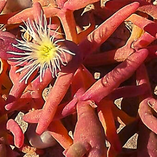Mesembryanthemum cryptanthum in Algeria: Succulent Rare and Adapted

Taxonomy:
|
Kingdom: |
Plantae |
|
Phylum: |
Tracheophytes |
|
Class: |
Angiosperms |
|
Class: |
|
|
Order: |
Caryophyllales |
|
Family: |
|
|
Genus: |
Mesembryanthemum |
|
Species: |
M.cryptanthum |
Mesembryanthemum cryptanthum is a small but
resilient succulent annual that thrives in Algeria’s more challenging desert
and semi-arid zones. While it may not have the showy flowers or large size of
more familiar plants, its adaptations to shallow, saline or gravelly soils make
it a key player in Algerian desert plant communities and a contributor
to native Algerian flora and biodiversity
Introduction
Mesembryanthemum cryptanthum is a modest yet fascinating succulent herb of the family Aizoaceae, well adapted to arid and semi-arid landscapes. Though often overlooked, it plays a subtle role in Algeria’s native flora, especially within desert pastures and saline flats. As part of the Algerian wild plants, native Algerian flora, and Algerian plant biodiversity, it deserves attention for both botanical interest and conservation.Synonym:
Aizoon theurkauffii
Mesembryanthemum forsskalii
Mesembryanthemum gaussenii
Mesembryanthemum theurkauffii
Opophyton forsskalii
Opophytum cryptanthum
Opophytum theurkauffii
How to
identify it?
Mesembryanthemum cryptanthum is an annual plant belonging to the family Aizoaceae , evergreen, papillary greenish-reddish plant depending on the season and precipitation, also known as baby finger plant. Its leaves are cylindrical in shape, branched at the base. Leaves are green, red, orange, and have axillary flowers that are white or white with yellow. Can grow in climates Mediterranean and Algerian desert blooms in February and June after rains in the desert.
Growth form: Succulent annual herb, decumbent or erect up to ~25 cm tall, but often prostrate when in flower.
Leaves: Succulent, cylindrical or sub-terete (sometimes nearly cylindrical), up to ~50 mm long and ~15 mm diameter in some populations. Smooth surface.
Flowers: Small, often white or creamy‐yellow staminoids/tepals, though less showy than many ornamental succulents.
Fruit/capsule: 5-locular capsule with valve wings sometimes reflexed/fused, typical of Mesembryanthemum species.
Habitat cues: Occurs in arid, dry shrubland or desert soils; look for surfaces with sandy or gravelly soil, often shallow. Presence of succulent annual flora is a clue.
|
Type
Of Plant |
Life
Cycle |
Height |
Flowering
Time |
Altitude |
|
Herbaceous |
Perennial/Annual |
0.50 m |
After the rains |
900 m |
|
Mediterranean |
Edible |
Color |
Abundance |
Toxicity |
|
Yes |
Unknown |
White |
Common |
No |
Other
Common Name:
|
Arabic |
Berber/Targui |
English |
French |
Other
Name |
|
Swabaa ghoula |
|
Babies’ toes,ice plant |
|
Blood finger |
Algerian Distribution and Where to Find It
According to the accepted distribution for M. cryptanthum, its native range includes Algeria (among others: Libya, Namibia, Angola, etc.)
However, exact locations within Algeria are less frequently published in accessible literature. The species is indicated for Northern Africa and desert/shrubland biomes.
Field inference: In Algeria you would likely find it in arid-steppe zones, saline flats, shallow gravelly or sandy soils, possibly in zones of the Sahara or southern Tell where soil is sparse, saline or seasonally wet.
Since precise GPS coordinates weren’t found in my search for Algeria specifically, I recommend exploration in western Algeria desert margins, e.g., near Béchar, Tindouf, or other arid zones with succulent vegetation.Related
species:
§ M.
crassifolium= Disphyma
crassifolium
§
M. crystallinum= Cryophytum
crystallinum
§ M.
edule
§ M.
Floribundum= Drosanthemum
Floribundum
§ M.
forskahlii
§ M.
gaussenii
§ M.
multiradiatum= Lampranthus multiradiatus
§
M. theurkauffi
Maire= Opophytum theurkauffiil












No comments: